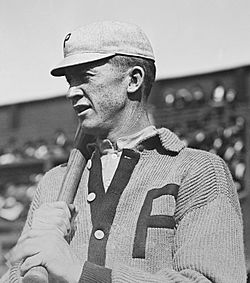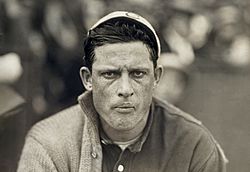Shutout (baseball) facts for kids
In Major League Baseball, a shutout happens when a single pitcher plays an entire game and doesn't let the other team score any runs. If more than one pitcher works together to stop the other team from scoring, it's called a team shutout, but no single pitcher gets credit for a shutout.
The rarest pitching achievement is a perfect game, which has only happened 24 times in over 135 years. The most recent one was by Domingo Germán on June 28, 2023. Before 2020, a perfect game was always also a shutout. A no-hitter (where the other team gets no hits) is usually a shutout too, unless the other team scores runs because of errors, base on balls, or other ways that don't involve hits.
The all-time record holder for career shutouts is Walter Johnson, who played for the Washington Senators from 1907 to 1927. He had an amazing 110 shutouts, which is 20 more than the next closest pitcher, Pete Alexander. The record for shutouts in a single season is 16, achieved by George Bradley in 1876 and Pete Alexander in 1916. These records are considered almost impossible to break today because pitchers rarely throw many shutouts in a season. This is because teams now focus on pitch count (how many pitches a pitcher throws) and use many relief pitchers to finish games. Complete games (where one pitcher plays the whole game) are also very rare now.
As of 2023, the active player with the most career shutouts is Clayton Kershaw, who has 15.
Contents
What Is a Shutout?
A shutout is a special statistic given to a pitcher who doesn't let the other team score any runs in a game. For a pitcher to get credit for a shutout, they usually have to pitch the complete game themselves. However, there are a few rare exceptions to this rule.
The first official shutout in baseball history is believed to have been thrown by Jim Creighton on November 8, 1860. In the very first season of the National League in 1876, teams played about 60 to 70 games. Back then, it was common for a team to have only one main pitcher who pitched every inning of every game! That's why George Bradley was able to pitch 16 shutouts in 1876, a record that still stands today (tied by Pete Alexander in 1916).
Over time, as hitting became stronger and teams started using more relief pitchers, shutouts and complete games became much less common. Since 1917, only a few pitchers have managed to throw 10 or more shutouts in a season.
In 1968, Don Drysdale of the Los Angeles Dodgers set a Major League record by pitching six shutouts in a row! He also had a streak of 58+2⁄3 scoreless innings pitched, meaning he didn't allow any runs for almost 59 innings. This amazing streak was later broken by another Dodgers pitcher, Orel Hershiser, in 1988, who pitched 59 consecutive shutout innings.
Only one pitcher in Major League history, Ed Reulbach, has ever pitched two shutouts on the same day. This happened on September 26, 1908, when he pitched both games of a doubleheader against the Brooklyn Dodgers, and the Dodgers didn't score in either game!
Red Barrett holds the record for the fewest pitches in a nine-inning shutout, with only 58 pitches in 1944. This was also the quickest night game ever, lasting just one hour and 15 minutes. Walter Johnson has the most Opening Day shutouts with seven. Jamie Moyer is the oldest player to pitch a shutout at 47 years old in 2010. In the playoffs, Christy Mathewson holds the record with four shutouts, including three in the 1905 World Series.
Can a Pitcher Get a Shutout Without Starting the Game?
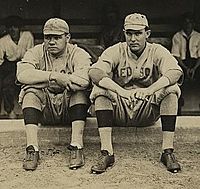
It's very rare, but a pitcher can get credit for a shutout even if they didn't start the game or pitch the entire game from beginning to end. This can happen if they come into the game very early, before the other team has scored any runs, and then they pitch the rest of the game without letting the other team score.
A famous example happened on June 23, 1917. Babe Ruth of the Boston Red Sox was pitching and walked the very first batter. He then got into an argument with the umpire and was ejected from the game! Another pitcher, Ernie Shore, came in to replace him. Shore then got the runner out (who was caught stealing) and didn't let any other batters reach base for the rest of the game. The other team, the Washington Senators, didn't score any runs. So, even though Babe Ruth started the game, Ernie Shore got credit for a shutout because he pitched the rest of the game perfectly and didn't allow any runs.
Shutouts in Shorter or Longer Games
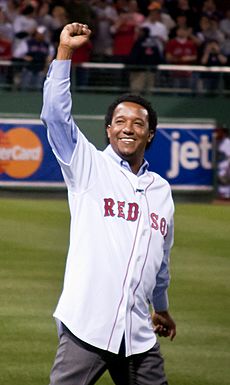
A standard baseball game is nine innings. If a game is stopped early due to weather, it can still be considered a "complete game" if at least five innings have been played. In this case, a pitcher can get a complete-game shutout even if they only pitched five innings, as long as the other team didn't score. However, no-hitters and perfect games are only official if the game lasts at least nine innings.
What if a game goes into extra innings (more than nine innings) and no one has scored? The same pitcher must keep pitching until the end of the game without allowing a run to get a shutout. If they are replaced or give up a run in extra innings, they won't get the shutout. This is very uncommon because starting pitchers usually don't pitch into extra innings.
One famous extra-inning shutout was by Jack Morris in Game 7 of the 1991 World Series. He pitched all 10 innings without allowing a run and was named the Series MVP!
The longest complete-game shutout ever pitched by one person was 18 innings! This has happened four times in Major League history.
When a No-Hitter Isn't a Shutout
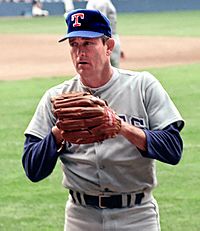
Most of the time, if a pitcher throws a no-hitter (meaning the other team gets no hits), it's also a shutout because they didn't score. But sometimes, a no-hitter can happen, and the other team still scores runs! How? They can score without getting a hit through things like errors, base on balls (walks), or being hit by a pitch.
Since 1875, there have been 322 no-hitters. In 25 of those, the other team managed to score runs without getting any hits, so it was a no-hitter but not a shutout. In only two of these games did the team with no hits actually win!
One example was on April 23, 1964, when Ken Johnson of the Houston Colt .45s lost 1–0 to the Cincinnati Reds, even though the Reds didn't get a single hit.
Team Shutouts
If two or more pitchers work together to prevent the other team from scoring, it's called a "team shutout." No single pitcher gets credit for it, but the team as a whole gets the shutout.
The Pittsburgh Pirates hold the record for the most consecutive shutouts by a team, with six in a row in 1903. They also hold the record for the most consecutive scoreless innings pitched with 56. The Chicago White Sox (1906) and Chicago Cubs (1907 and 1909) share the record for the most shutout victories in a single season, with 32 each.
The largest win in a shutout game was 28–0, when the Providence Grays beat the Philadelphia Quakers in 1883. More recently, the Cleveland Indians beat the New York Yankees 22–0 in 2004.
Top Pitchers for Shutouts
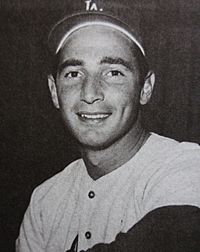
The pitcher who has the most shutouts at the end of a season is called the league leader. Leading the league in shutouts often means a pitcher is one of the best. This can help them win awards like the Cy Young Award (for best pitcher) or even the MVP Award (for the best player in the league).
Many famous pitchers who led their league in shutouts also won the MVP or Cy Young Award. For example, Sandy Koufax led the National League with 11 shutouts in 1963 and won both the MVP and Cy Young Awards that year.
Walter Johnson, Pete Alexander, and Cy Young each led their league in shutouts seven times! They are also among the top pitchers for career shutouts.
With fewer shutouts happening today, a pitcher might lead their league with only 2 or 3 shutouts in a season. For example, CC Sabathia led both the American League and National League in shutouts in 2008, even though he only had two in the AL and three in the NL.
For a full list of all-time shutout leaders, you can check out List of Major League Baseball career shutout leaders.
Top Active Career Leaders
(as of the end of the 2020 season)
| Rank | Player | Debut | Shutouts |
|---|---|---|---|
| 1 | Clayton Kershaw | 2008 | 15 |
| 2 | Adam Wainwright | 2005 | 11 |
| Ervin Santana | 2005 | 11 | |
| 4 | Justin Verlander | 2005 | 9 |
| 5 | Johnny Cueto | 2008 | 8 |
| Derek Holland | 2009 | 8 | |
| Corey Kluber | 2011 | 8 | |
| 8 | Cole Hamels | 2006 | 7 |
| Madison Bumgarner | 2009 | 7 |
Pitchers with 10+ Shutouts in One Season
- Denotes a member of the Baseball Hall of Fame
See also
- Baseball statistics
- List of Major League Baseball annual shutout leaders
- List of Major League Baseball career shutout leaders


